Many people who take their bikes on MAX have had to skip a train at least a few times because it’s too full of people.
But park a bike at the station because all the hooks are full? Not so common. Most riders will wheel it on anyway if they can, even if it’ll block other people from boarding down the line.
Those are two findings from an online survey, conducted as part of TriMet’s bike plan, that explored the problem of people trying to take their bikes on MAX and bus but running out of space.
Here’s the question about skipping trains that can’t fit a bike. 21 percent of respondents said this happens to them “often,” and another 38 percent said they’ve done so once or twice:
And here’s the question about whether people would park a bike if all of the train’s four to eight hooks were full. 62 percent of respondents said they were “very unlikely” to do this, and another 13 percent said they were “somewhat unlikely.”
Overcrowded rush-hour MAX trains are a significant problem on TriMet’s busier routes, with the Hillsboro-to-Gresham Blue Line being the most crowded. One solution, of course, would be to run more trains. But train operators cost money, and because of the Pioneer Courthouse Square track crossing and the Steel Bridge bottleneck, the system’s rush-hour capacity is almost maxed out.
So for years, TriMet has been trying to follow the example of many European cities and improve the bike parking near transit stations. It’s built secure pay-to-park bike-and-rides at the Sunset, Beaverton and Gresham Central transit centers plus two stops along the new Orange Line. Another one at the Gateway Transit Center has been long discussed.
It’s always been a little odd that TriMet charges a few cents per hour for people to park their bikes in these while continuing to offer free parking to anyone who arrives by car.
Advertisement
In its survey, TriMet tested the public’s appetite for more paid bike-and-rides by asking what people would be willing to pay for secure bike parking. 78 percent of respondents said they’d be willing to pay something:
And 58 percent of people said that some sort of improved bike parking would make them more likely to “ride a bike to transit and use the bike parking.”
With at least one central-city bike sharing system finally on the way next summer, it’ll be interesting to see whether more people who currently bring their bikes downtown by transit will buy bike-share memberships in order to leave their personal bikes at their home stations. Based on TriMet’s brief description of the service, 40 percent of respondents said they’d be “very” or “somewhat” likely to consider this. But without much public understanding of bike sharing and without knowledge of where bike sharing stations will be available, it’s hard to say how reliable these figures are:
The TriMet survey did have one very clear finding: people who combine bikes and TriMet are big fans of being able to use space at the front of buses to store their bikes.
Bikes and transit are the killer combo for helping people escape car dependence, and TriMet deserves credit for trying to find ways to make them work together. Hopefully the solutions they find to overcrowding will continue to recognize that bikes aren’t a problem to be managed away but rather an asset to capitalize on.
— Michael Andersen, (503) 333-7824 – michael@bikeportland.org


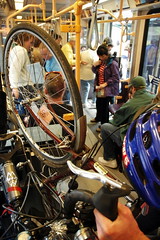
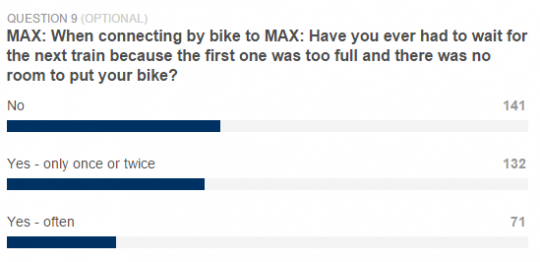

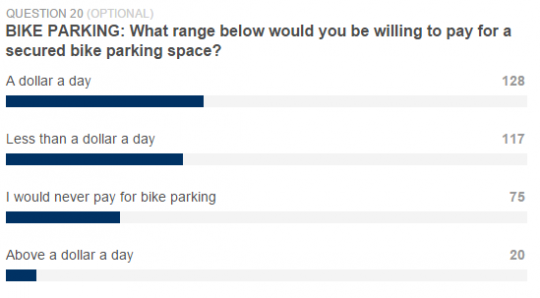
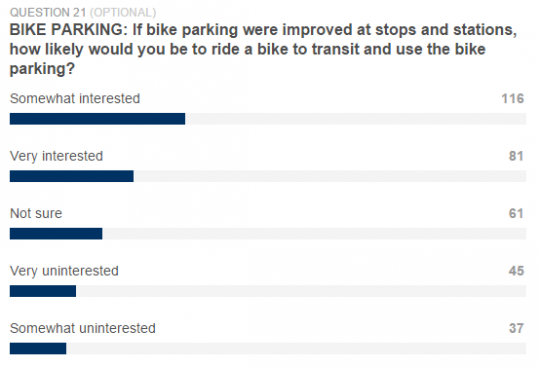
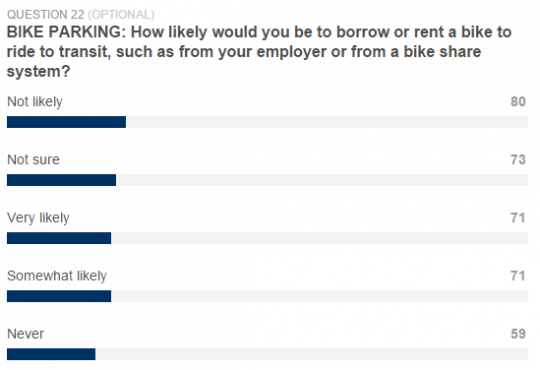
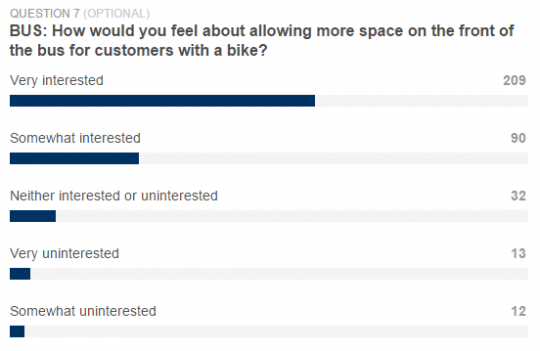
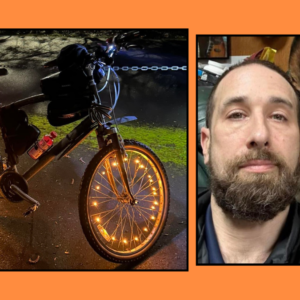
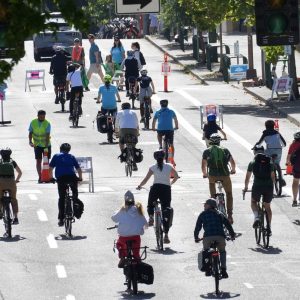
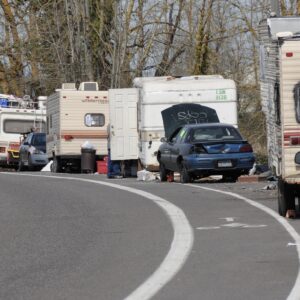
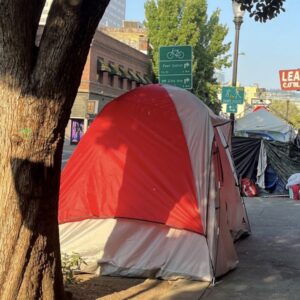
Thanks for reading.
BikePortland has served this community with independent community journalism since 2005. We rely on subscriptions from readers like you to survive. Your financial support is vital in keeping this valuable resource alive and well.
Please subscribe today to strengthen and expand our work.
Bus 56 needs a to take on 3 bikes for Scholls Ferry.
Trains could be retrofitted with front racks that could be loaded from the platform (i.e from the side), and increase carrying capacity by 2-4 bikes.
I’ve always thought the same thing. I’m wondering though if that would create a tolerance issue along the line, i.e. would they hit anything? I know the mirrors on the train stick out fairly far but would a bike stick out farther? Also I think you would need some kind of theft prevention. I could not being able to stop a thief if the train was really crowded.
Doh. Should have read your comment closer.
The design I’m thinking of wouldn’t stick out the side at all — it would all be in front, like on buses (though a different implementation, obviously). Theft would probably be no bigger a problem than theft from buses.
I personally would never use something like that because there is too high of a theft risk, as it stands i always sit at the front of the but when i have my bike to make sure I can have a chance to run after someone who might try to steal my bike
Any reason to ask for a front rack instead of a rear rack? Front rack will be a rear rack when the train gets to the end of the line and backs out to go the other way. Also, MAX railcars aren’t permanently coupled. Would there be an operational impact if you can only connect the cars on one end because there’s a bike rack on the other side?
Good points. I like the idea of a front rack because drivers can see what is going on with it; this matters both for safety and theft reasons.
Were I relying on multimodal transit with a bike, a Bike Friday Tikit would rocket to the top of my wishlist.
With the superfast “hyperfold” you can easily get them up to $2k. I’m the first to admit that the savings won’t pencil out too quickly, but you never have to wait for the next train/bus, you can ride it at both ends, and best of all: it’s another bike.
You could start with a basic Dahon or Tern, but why not go straight to the best, made right here in Oregon?
And don’t forget the even quicker folding Brompton!
I have both a Tikit and a Brompton. The Tikit folds in nearly half the time. What the Brompton does is fold smaller. Of the two I prefer riding the Tikit.
If Trimet instituted paid car parking (and charged more than a pittance) and put in secure bike parking (even if it costed a few cents) at every feasible station (i.e. at least half of stations), I bet they’d get lots of bike-to-transit.
Plus including bike “feeder routes” to the stations with secure bike parking in future high capacity transit route planning.
This. If people can’t safely ride to the station in the first place, they won’t bother riding at all.
People are already riding their bikes and taking them on the train because they don’t want to lock it up.
Locking it up at the station isn’t really an option when there is a 4-10 mile ride on either end to get to the train.
In most cases, the main problem with paid park-and-rides is that people would park cars on nearby streets to avoid the park-and-ride. The simplest solution to that is probably a cheap local parking permit system like the one Portland already uses for the Central Eastside. I don’t think Gresham, Beaverton or Milwaukie have any such systems yet.
The deeper problem with paid park-and-rides for TriMet is that the agency relies on free parking to goose ridership at the last stop on the line, which helps win them federal grants. That’s because federal transit formulas foolishly reward systems for maximizing the number of miles traveled by transit rather than rewarding the number of auto trips reduced.
Yup… such a policy would probably have to be accompanied by an increase in the Trimet payroll tax or some other type of local funding in order to make up what Trimet would lose from the federal grants. I’m dreaming big here, OK? 🙂
Do park and rides contribute a huge source of ridership? Or do they do more by getting support from local politicians? Charge as much as people on this site have asked for in the past and it will be cheaper for people to drive the whole way, so they will.
Why measure reduction of ‘auto trips’ as the most important feature? Is a one and a half mile drive to a parking lot just as bad as a twenty mile drive on an overcapacity highway? Some here will bike that far in the rain over a 500 foot hill, but it’s not common. You’ll be able to get far more people to consider replacing the 1.5 mile drive to the station with a bike ride. It reduces auto miles significantly and sets you up to have a much better chance of eliminating them, but it’s still an ‘auto trip’ so it doesn’t count in your proposed metric. What about someone who moves near a station so they can walk to transit. They wouldn’t have wanted to drive in traffic each way, and only set themselves up to make the trip because of the investment in transit. No auto trips eliminated.
You’re right, I should have said auto miles traveled, not auto trips.
Given the crowding on the Blue line, I think an argument could be made for paid parking at all park and rides. Subsidized car parking is a great way to build ridership on new lines, but it makes sense to start charging once the lines begin to hit capacity.
This could be a demand-based system. Free during off hours and modest during peak hours.
Long-term, a parallel bridge will need to be built next to the Steel. A subway is likely too expensive for this city, but Trimet has shown with the Tillicum that they can build a new bridge over the Willamette without breaking the bank (~$150 million).
Yep – hit the nail on the head. This was part of the problem we had when planning then CRC LRT, car park & rides were given points in the ridership calculations for facility planning but bike parking or bike sharing were not [back then].
“In most cases, the main problem with paid park-and-rides is that people would park cars on nearby streets to avoid the park-and-ride. …” andersen/bikeportland
A worse problem, could be, depending on the amount required to park their cars, people might decide to not ride the train, and drive instead.
From first hand observation, what I can say about the Elmonica transit station park and ride, is that on weekdays, its big parking lot is usually full. Not sure how many parking spaces there…three or four hundred?
For a train, four hundred people isn’t a great number of passengers, but on ‘at capacity’ roads, the possibility that free parking is helping keep that many motor vehicles, (and could be more if they’re not all single occupancy.) off the commute routes to work, could be significant.
The bike parking facilities should accept the new Hop card. Currently, you have to order a special card online to be able to use the facilities and can’t purchase at the station. This is an unneccesary deterrant to using the facilities.
Also, whatever happened to the bike parking facility planned at Goose Hollow?
If one can purchase a card at the secure bike parking a dollar or so a day, what would keep bike thieves from purchasing cards and stealing bikes?
The parking facilities are monitored by security cameras and also you should lock your bike up inside anyway. Maybe instead of paying people to stand at train crossings, TriMet could pay for security guards at bike parking facilities.
We already know that the cameras do not do much deter theft at transit centers.
Solo bike lockers are needed.
This is a nice problem to hear about; that Max space for bike users and not is in such demand.
The Dutch have two bikes, one to get to the train, and one to get to work. When I commuted to Hillsboro, it was asinine to take a bike to ride 50 ft from the Max to Pacific but I had to do it because there was no way I’d leave a bike downtown. That said, if it costs a ton of money to park a bike, then its not going to get used.
Bike lift system like the Trampe bicycle lift in Trondheim, Norway.
Or https://en.m.wikipedia.org/wiki/Trampe_bicycle_lift
I’m guessing the >$1/day crowd isn’t biking every day. One solution to this problem is get an ebike – you’ll save on the trimet fare and it can pencil out pretty quickly. $5/day savings is $1250/year
“But park a bike at the station because all the hooks are full? Not so common.”
Once I parked my bike at a Trimet station. I figured it was a safe place because it was literally right in front of a security camera. I returned to find it stripped to a frame, a chain, and a seatpost. Trimet said they would not lift the security camera footage because bike thefts aren’t “active investigations”.
I see those bike kennels at many stops but seldomly see means to rent them.
How long did you leave the bike there?
Not more than six hours, during the day.
Wow.
FYI the “kennels” are rented for six months ahead of time. http://trimet.org/bikes/lockersavailable.htm
Clearly not useful for a day to day type thing (which I think people would use).
Looking at the Washington Park station (because it was near the top of the list), there is a crapton of space around that station (and I’m referring to the imperial crapton, not the smaller metric one). If Trimet wanted to, they could create enough kennel space to shelter every stolen bike in Portland, with plenty of room to spare.
If there is a shortage of bike storage space (at this station, at least), it is because Trimet has chosen that there be a shortage of bike storage space.
The long-term rental is, however, useful for storing personal items in the locker for when you arrive. I keep a change of clothes & shoes inside. Wouldn’t work with a daily rental.
I basically sleep in mine.
I see stripped bikes at the Hollywood TC all the time.
“It’s always been a little odd that TriMet charges a few cents per hour for people to park their bikes in these while continuing to offer free parking to anyone who arrives by car.”
Middle of the Road guy – care to comment?
http://bikeportland.org/2015/11/02/kaiser-parking-plan-could-threaten-key-bikeway-but-may-boost-lloyds-boom-167178#comment-6583570
Just this morning I was thinking of getting myself a folding scooter to zip down to and take on to the Max on days I decide not to ride all the way in,something like the Kickped. Not a solution if you live too far from the station, but ok for a mile or two I think.
I’ve been using a folding scooter the past week and it works great! For a mile or less it’s very convenient and you can’t beat the portability.
I’ve never had a personal reason to use a Bike Share program, but this is where Bike Share would be useful to me. Max is 1.3 miles from my home and has great bike park facilities. But once I get off Max it’s still 2+ miles to work by trail. If I park my bike (to avoid train crowding) then I have nothing for my commute to work once I get off Max. If I had access to bike share I could grab a bike and finish my short commute from the Max station to work and I would be much more likely to leave my own bike behind in the MAX bike parking facility.
This is a great example of how bikeshare can make transit more accessible and useful. I’d love to have bikeshare to connect to light rail, it would mean I’d spend a lot more time on the train rather than the bus.
That why TriMet should run the bikeshare, then there is a better incentive for integration.
From trimet’s perspective, “bike crowding” on trains is a good problem. I like to look on the bright side: at least they’re listening to bikers, even if they don’t plan on making any big changes.
Increase fare inspectors by 10-20x between the months of April and October and it may free up more space for the bikes.
….something tells me the homeless guy with three backpacks and a dog does not have valid fare.
No way will I leave my bike at a max stop…ever. I don’t trust the town or the other bike riders. I get off at Beaverton TC when I do take the train over the hill from Goose Hollow. The way I see other bikers behave inside that locked bike paddock there scares me. Watching as other bang their bikes around and into other bikes…nope. I won’t deal with that. I will continue to ride up from Lloyd Center to Goose Hollow, wait for a train or four to grab a hook and take my bike with me. Plus, I ride from the TC to my home near Wash Sq, so it wouldn’t work to leave my bike downtown.
Lastly, I had once heard from a fare inspector that bringing your bike on to the train and not hanging it but standing it in the aisle way was a ticketable offense. True or not?
Even is not ticketable…the riders who do this should be shamed off the train.
I’m not sure you should automatically be shamed off the train.. if the train is busy then yes, definitely not the right thing to do, but I have done it when the train was pretty quiet but the hooks were nonetheless all full. There was tons of room to stand with the bike and it bothered no-one.
Not necessarily ticketable, though in most cases a fare inspector or operator will tell you to remove your bike and wait for another train with hook space. The real issue is pissing off train users who cannot enter a packed train because your floored bicycle is in the way. If we want to build good will between bike riders and other transit users, blocking trains is not the way.
A folding bike is perfect for this sort of multi modal commute. The less expensive ones that are still good quality (Dahon, etc) start at $400 new.
If bike overcrowding on MAX becomes a big enough problem, it may make sense to remove some seats. That would also make more room for standees.
Curious what the constraint is on more MAX capacity?. What prevents trains from being run at higher frequency?.
MAX has some limitations not found in other cities’ light rail. The trains travel on surface streets, which limits their length. I wonder if reconfiguring traffic flow (more dedicated lanes) in a few downtown areas would permit three car trains instead of two car trains.
When i moved here, about a decade ago, i looked at MAX and the freeway system, and thought they would have a hard time keeping up with growth over the coming decades. So I decided to live close-in, and accept the trade-offs (more expensive, less space, a bit more grotty). That has turned out to be a lucky decision.
The only way to get longer trains downtown would be to build a subway. This would solve the Steel bridge issue and greatly expand capacity. Much of the rest of the system could be modified to support 3 or 4 car trains without too much work, but downtown is a huge barrier. We’re talking billions. If we can’t even manage to pay for light rail on the SW corridor, I don’t know if a subway will ever happen downtown.
Consolidating stops downtown would improve speeds and throughput. SW Jefferson, Pioneer place, Galleria, Skidmore Fountain, and Convention Center stops should all be closed to speed up the trains through downtown.
A cheaper alternative to a subway would be to let a longer train block cross traffic when it is at a stop. That said, I’d rather see more frequent service than longer trains.
But then you’re limited by signal timing where the lines cross, and on the steel bridge.
Pull out a couple stops, and rebuild the remaining ones across 2 blocks? Then you have Tunnel issues. Washington Park is only long enough for two.
Washington Park would be another problem. It is possible to extend the platforms to accommodate 4-car trains, but it would cost a bit. 3-car trains could probably fit today. They would just need to set the stop line further down the platform, so that the first door on the leading car lines up with the very edge of the platform, and the last door on the rear car lines up with the other edge. Again, the bigger challenge is downtown, unless we decide that MAX trains can block major downtown streets for minutes at a time while they wait for passengers to load/unload, get stuck in congestion, etc.
Are you even hearing what lop and others are saying here? This adding more cars is not going to happen and given the physical constraints, never mind the financial ones, is absurd.
Often the blue line to Gresham during rush hour seems to be missing cars. Couldn’t they just add another car to increase capacity and not have to pay for more runs?
For most trips my E-Bike is faster than the bus or Max and a lot more fun. Your outside, getting exercise, breathing fresh air, maybe stopping by a friends house on the way home. The e-bike is a great solution to the “too many” bikes on MAX. My next question? Why are bike commuters riding MAX? MAX uses way more electricity (energy) than an E-bike making the E-Bike much more environmentally friendly than MAX.
The MAX will be running whether or not you’re on it, but every time you charge up your E bike you are consuming energy which is usually derived from some kind of polluting industry.
So it’s actually impossible for someone to use more energy by riding the MAX: it’s not like the train isn’t going to run if any individual person chooses not be a passenger.
So E bike use is technically more polluting, simply because you’re electing to use electricity from the grid to power your ride rather than your breakfast, every time you ride it.
And that’s not even getting into the rare earth minerals which are used to create the E bike’s battery…
Cute advert though!
You are mostly right, but it does take a little more energy to run the train when there are more people on it (and it is therefore heavier). So it is not impossible that the Max uses more energy.
Sorry… feeling pedantic today.
Yes you are technically correct…up until the point were 1 more rider causes Trimet to add service frequency or buy a new train carriage / bus.
FYI: Sorry it’s not an advert, my e-bike changed my transportation options for the better. I charge my bike at night, that’s when most wind power is generated. They’ve been dumping wind power because no one uses it at night. I’m converting wind power into transportation-that’s gold. It’s not if, it’s when you finally get an e-bike. When I was biking through Spain, in the middle of no where and I came up on an 80 + year old touring on his e=bike, he was my inspiration for continuing to bike no matter how old you are. It’s going to happen to you too, just wait.
Then again, people could just ride their bloody bikes. It’s so sad that our cycling community, advocates especially, are under the impression that riding ten to twenty miles and going over a small hill or two is too much for a normal person to do. It creates a social barrier where the physical barrier is almost non-existent.
Depending on your definition of a “normal person”, 10-20 miles over hills is a very long ride.
Because when you live 9 miles from work and it’s 34 degrees, pouring rain, and winds are 30+ mph….the MAX is a darn good alternative.
Something about those West Hills gets me to ride the Max once in awhile from Sunset to Goose Hollow and back. I’ve noticed that at Goose Hollow almost every cyclist gets off and starts riding. I started getting on at Washington/12th because of the crowding problem instead of riding to Beaverton or Sunset. My destination is Delta Park area and that really is the bottle neck, no good path across the West Hills.
False. There are several great, low-traffic routes over the west hills from downtown. (Montgomery to Patton to Hewitt, Park to Fairview, and Jefferson to Kingston) Like I said below, only a very small percentage of bikers have the time, equipment, and ability to do it regularly.
So your definition of great, low-traffic routes are ones that very few cyclists can use due to lack of equipment, time, or physical capabilities?
Like I said, there is no good route. Both you listed are 1,000′ elevation gains. If there was a tunnel for bikes only like the Max tunnel that got us through the West Hills almost all the cyclists that get on at Sunset and off at Goose Hollow would be taking that instead of paying $2.50 each way.
David, I appreciate the discussion, but you’ve got me wrong. Let me write it for you again: right now, this very second, there are very few cyclists who can do it day in and day out. This does *not* mean they cannot practice hills, get stronger, and change up their bike or schedule if they have to. It can be done. It took me 6 months to get strong enough to do it 10 times in a week (Monday thru Friday, morning and night). After that its gravy: you just keep getting stronger, leaner, and faster.
In my opinion, any paved route with low vehicle traffic is a good route, and if you’re trying to get over the west hills on a bike, you should expect climbs and descents.
this is why more people should ride skateboards to their train or bus stop! No racks? No worries!
OR just pave all the Trimet tracks and turn them into bicycle/ pedestrian lanes. Saves the taxpayers money, increases bike usage, increases business for small business bike shops, no unions. #pavetrimet
Maybe save the pavement and just get some railbikes.
Not surprising that respondents said they are unwilling to lock their bikes at the transit stations. Aside from the risk of theft, there’s the more practical matter of needing the bike on both ends of your transit commute. It would do me little good to ride my bike to the MAX station and lock it up there, only to have to walk the mile from my destination MAX station to my work.
The “two bikes” concept sounds great, but would only suffice if there’s a long-term bike storage solution near where people work. From what I can tell, the only long-term bike storage facilities are built in tandem with the park-and-rides which are at the route’s extremities, not generally where people work. I’ve emailed Trimet to see if they are considering creating more rentable bike storage options for companies to use for small company-owned “bike fleets” but haven’t heard back from them yet.
Overall I’m pleased that Trimet is addressing combining bikes and transit, as clearly the current situation is wanting. Hopefully this is the start of a larger dialog between Trimet and other agencies (e.g., Metro, PDOT) about how best to serve the whole commuting need (i.e., the “last mile” problem).
The Dutch and Germans have grand underground bike parking garages… I don’t know what I’d do if I had to take the MAX to work part way and there was no guarantee I could get my bike on board, with a 2-3 mile cycle ride on the other side, say I lived in NE and worked in Beaverton. Probably move closer to work. Or try to board the train at a less popular location.
When my parents used to live on the growth boundary in Hillsboro, I would often ride from my house at 82nd in SE to the Goose Hollow stop (because it’s faster than boarding the train and taking that into downtown Portland), and then get off in downtown Hillsboro and ride a few miles to their house. This isn’t typical for a cross west hills trip, but it’s not atypical for the type of use that a bike/MAX combo should expect. There probably are some who don’t need to take their bikes on the train and do, but given the prevalence and continued rise of bike theft, I don’t see how we can blame them for not wanting to make themselves victims.
All that said, the possible paths that Tri-Met can follow if they _do_ wish to provide any amelioration of the crowding issue are: (A) Increase bike carrying capacity or (B) disallow bikes being taken on to the MAX. I don’t see (B) as being a particularly desirable solution. For (A), there are some ideas already mentioned above, and I would submit these:
-Add another car during peak hours only for bicycles and their riders
-Remove seating from cars during peak hours, allowing higher passenger density
-Reserve a portion of a car for space efficient, lockable bike storage
What about option C, incentivize people not to bring bikes on board/provide alternatives that may serve some people better, without actually banning bikes on MAX? Secure bike parking at all stations, without the barrier to entry of a separate fare card. When they roll out HOP it should replace or supplement the existing bike cage access card. Partner with bike shops to provide maintenance service to bikes to make having a station bike a little easier. The OHSU tram bike valet offers tuneups, I assume people find the service convenient even when they can take their bike home at the end of the day, should be more attractive for one never taken home. Assuming bike share downtown works well look into offering a similar service elsewhere in the metro area. For the purpose of offering an alternative to bringing a bike on board for a ‘last mile’ trip it is not necessary that this is a single system. If people are allowed to take a bike share bike from Gresham to downtown Portland that would cause some reliability issues, if there was a separate bike share system in Gresham that wouldn’t be an issue. Like on the Copenhagen metro MAX could charge those who bring bikes on board the train to moderate demand.
Railcars are expensive, buying an extra car for each train would cost a lot of money. Their last order cost ~$4.4 million per car. The total MAX fleet is ~145 railcars. If they want to add a third car to each train it could cost a few hundred million dollars for the railcars alone. Downtown it would mean blocking a cross street whenever a train is stopped, no walkers, cyclists, drivers, freight, or emergency vehicles would be able to get through. At Washington park it would mean one car would not stop at the station, or the train would have to stop twice, move forward 100 feet after the first stop so the third car can reach the platform. I don’t know how the signal system is setup, but the effectively longer dwell time at that stop may lead to throughput or at least reliability issues. Elsewhere in the system adding another 100 feet of concrete to extend a station platform would be less complicated. MAX has to slow down at several points (turns, steel bridge etc…) and cannot accelerate until the entire consist clears the slow zone. So a third railcar would lead to slightly longer running times as well.
Removing seats is generally very unpopular with transit users, ~90% of MAX riders do not bring bikes on board or to access the station. Seats that fold up during peak hours to make more standing room aren’t received all that much better.
Bikes are space efficient compared to cars. But not so much that everyone bringing a bike on board the train is feasible.
In relative terms, bikes take up a huge amount of space on the train; the amount of space someone could be standing in if the bike wasn’t occupying it. If the practice of bikes brought on board were to really take off, in theory that could mean a fifty percent reduction in the train’s passenger carrying capacity. Not that it would actually ever happen here.
I haven’t used one personally, but what I hear of them, folding bikes sound like they may be a great way to minimize the amount of space occupied by bikes brought onto the train.
I made one attempt to cut out the dark winter middle section of my long commute by taking the new Orange line on a rainy night. The train wasn’t crowded but my old touring bike was too heavy for my limited upper body strength — I could not lift it by its front wheel up to the hook. It felt like the whole front wheel was going to fall back and smash me in the face as I struggled with it. Someone offered to help put it up there, but I didn’t think I could get it back down by myself, so I stood there awkwardly with its two wheels on the floor. So much for that idea.
Instead of the 2 car articulated and coupled trains TriMet should be buying 5 car articulated unit trains with the middle car exclusively for passengers with wheels–bikes and chairs–no seats.
Indeed. Open gangway trainsets would provide additional space for bikes and people. There is no reason for Trimet to run single-car trains anymore, and even if they need to, they have plenty in the fleet now.
The Orange line train orders should have been open gangway, as should all future orders.
How will a 5 car train fit downtown’s short blocks? For example, the MAX stops at Pioneer Square. Should the 5 car train block Broadway and 6th for cars, pedestrians, and cyclists, by extending over to the adjacent blocks? Should passengers queue up in the middle of the intersection to board the cars that end up there?
I’m one of those folks who would end up needing a bike at each end of my MAX ride. I also don’t have a standard size-&-shape bike – I ride a cruiser style, which doesn’t fit in TriMet’s bike lockers. And since there’s no secure bike park-&-ride facility at most of the MAX stops, I wouldn’t have anywhere safe to park my bike anyway. It’s highly unlikely I’d use a bikeshare program, as I already have a bike. I like my bike. And my bike fits me. I ride a cruiser style because I have physical issues that make the standard bike shapes difficult at best, and more often terribly painful, for me to ride. I’ve also got the issue of trying to get the bike up on the racks (too heavy, doesn’t fit, a bitch and a half trying to get it back down). So I’ll just be glad I don’t have to do any actual everyday bike-&-MAX commuting, and that it’s more about doing errands and recreational riding.
I haven’t heard exactly why trimet can’t run 4 car trains. I have heard other light rail systems block intersections. I laugh at trimets 2 car train system.
Our 200′ downtown blocks can only accommodate 2 cars. Take a look sometime – two trains maxes out (as it were) the full block face.
Yes..I know.
It’s still not an issue. Trains block intersections all the time. Trimet continues to propagate the lie that somehow stormtroopers will descend upon the agency if they even propose longer trains. So what..cars will have to wait longer at the red.
Actually, not just “…cars…” (people drive and travel in cars.), but all other cross traffic, including people riding bikes, would be blocked by train length over the present 200′ extending into the intersections. That would not just be an inconvenience to people driving, but also a significant contributor to road congestion…one of the very things that light rail downtown is intended to help reduce.
Heavans to betsym during rush hour, a few folks would have to wait for hundreds and additional second. Oh me…oh my. Bikes would go around and Peds would too. I don’t care about cars.
Would you expect MAX riders to enter and exit the train directly into the middle of an intersection? Or should the four car train stop, let passengers in the first two cars enter and exit, then move forward a bit, stop, let passengers in the last two cars enter and exit? Doesn’t seem practical.
Given the short blocks, I think greater frequency of trains is the only feasible option.
How about adding extra trains during rush hour servicing only Hillsboro -> Goose Hollow (and back)?
That’d increase people moving rate avoiding downtown and the Steel Bridge. Lots of people (myself included) just pop off at Goose Hollow when returning east from suburbia at the end of the work day.
(similarly on other dense lines)
After all, there are already red line trains that stop at the Beaverton TC from DT and turn around. It sure makes more sense to alleviate rush hour by having trains service the fuller routes.
Transit doesn’t go from where you are to where you are going, but with a bike you’re within 4-10 minutes on each end. Unfortunately, stations are spaced for people walking, so it stops so often that you can just bike the whole way in the same amount of time, but never have delays for waiting, missing the train/bus, or congestion. With 1/4 as many stops and 10x the bike space, we could have usable transit.
And thereby make MAX useless for the large majority of people who walk instead of bike?
Only 3/4 of them? Maybe some would be willing to run to get on and off? The max isn’t as stop-addled as bus lines until you want to get from downtown to the airport. Go by Trebuchet, I always say.
You have stops at NE 11th, Hollywood/42nd, NE 60th, NE 82nd, and Gateway/99th. All of those should be kept. But between NE 11th and the convention center do you really need a stop at NE 7th? Do you need the Old town stop and the one at skidmore fountain? On Morrison you need to stop at 3rd and at 5th? In some cities there are trains longer than the distance between some of the stops downtown…Stop consolidation would probably be a hard sell, and eliminating 3/4 of stops is probably pushing what would be reasonable, but eliminating some stops to speed up the train could be done and still let the people who can walk to and from MAX today continue to do so.
The Max is critical for many westside bike commuters because only a very small percentage of bikes have the time, equipment, and ability to get over the west hills.
For perspective each type 5 MAX train cost about 4.4 million dollars. The cost of a single LRV would cover over 4,000 bicycle share bicycles. Clearly there are other capital expenditures necessary but it would not be unreasonable to think TriMet could run a pilot program similar to OV-fiets in The Netherlands. Secure bicycle parking+bicycle share all integrated into the fare card system. Initially, bicycles/parking at a few key transit centers along the MAX+WES rail lines would be sufficient and then grow the system as demand changes.
I’ve lived in and traveled a lot in Europe. I’ve been on lots of buses and trains. I’ve ridden my bike. I’ve seen buses and trains everywhere. I’ve seen bike riders all over the place. I’ve never, ever seen a bike on a train or a bus. A bike can get you to transit – but it doesn’t need to go with you on transit. Maybe the question Tri-Met and the rest need to be asking is why do people feel the need to take their bike on the train, and address that.
I saw bikes on trains all the time in Germany. Maybe not on the equivalent of the streetcar, but certainly on the equivalent of Max (i.e. trains between cities).
You mean on the equivalent of Amtrak.
I’m not talking about the long distance trains; more like the ones people commute into the city with.
http://www.bicyclegermany.com/what_to_expect.html – “You can bring your bike right into the bus or streetcar if there are no bike racks in the conveyance. … During rush hour, bikes may be prohibited on busses and streetcars.”
Lots of bikes on Dutch inter-city trains, but those are heavy rail and wider than MAX, with room for bikes near the doors. No bikes (except folders) on buses or city trams, though.
Stuttgart’s Zahnradbahn has a neat idea. While it’s a cog rail (West Hills surface route, anyone?), a flatbed bike car could be used on MAX lines outside of the downtown core’s 200′ platforms. The flatbed would get shunted off the inbound track at the last “long” platform and onto the outbound track, providing shuttle service for bike riders to get from outer neighborhoods into central city where they ride the last mile. Picture:
http://www.cyclelicio.us/2009/bikes-on-board-stuttgart-cog-railroad/
Nice!
Oh my…I would think our illustrious engineers could figure out something.
Good luck with that trillion dollar subway.
There’s apparently no way to get through to some of these guys…
I actually bought a folding bike several years ago precisely because of this problem. Sorry folks, it’s not the panacea I expected. Here are my observations from commuting with a folder for about a year:
– Although I was previously missing enough trains to be getting fed up with it, it was really probably like a quarter of the time.
– So when I got to the MAX platform and folded up my bike, which only took 20-30 seconds but was kind of fussy and fiddly, more often than not I found out my efforts (which i’d have to reverse upon disembarking) were pointless. And once folded it doesn’t easily hang from a hook.
– A 20″ folding bike, folded, is still a pretty big package. It’s really too big to drag to a double seat with you, and there isn’t quite enough space between the wall of the train and a bike hanging from a hook. So what do you do with it? A folding bike does give you more options on places to sit with your bike next to you.
– Most times when the train was too crowded to bring on a non-folding bike, it was crowded enough with standing passengers to make a folded 20″ bike a hassle too. At best it’s like having a stroller or a very large suitcase, though dirtier and pointier – people will help make room for you, but sometimes grudgingly.
– The only people I saw having a really easy time of it with folding bikes had 16″ wheels. Bromptons were overwhelmingly the easiest thing to deal with on the train.
– Even though I have one of the highest-performance folders around and equipped it with fast tires, it was noticeably slower than a typical cyclocross bike. For a commute up to 5-8 miles or so I wouldn’t have minded. But since I only rode MAX in the morning and usually biked the full 12-14 miles home over the West Hills in the evening, I started hating the slowness of the ride home.
So my advice is if you’re thinking of getting a folding bike to deal with MAX crowding, don’t bother with 20″ wheels. Go small and get a 16″er. Dahon makes a decent one for a few hundred bucks, or you can splurge for a Tikit or (for the ultimate in packability) a Brompton. Do this to solve the last-few-miles problem, but don’t expect to enjoy doing hour-plus rides on a regular basis with your folding bike.
One possible solution, which I’ve long advocated, would be a bike shuttle over the West Hills. Buy a few vans pulling flatbed trailers outfitted with bike racks, and run them every 10 minutes back and forth between downtown and Sunset and/or Beaverton TC. Problem SOLVED!
TBH, the bike issue won’t really be solved by more covered areas. It could most definitely lighten the amount of bikes on trimet, but it really depends on where the person is coming from and where they are going too, meaning access to a bus or max that is going to where they are going. It’s entirely possible that the reason people are riding is because their isn’t a bus that goes to where they need to go.
I did notice that the WES Commuter rail has a bike specific car. Maybe that’s a solution if they problem gets worse?
I’m a bike currier for Jimmy John’s subs, I’m homeless and working to pay child support and get off the streets. I stay at a shelter on 122nd (east side of the Willamette River) I work on 19th (west of the river) I have to be to work by 9am, and it’s important to be fresh and not exhausted when I show up for work… since I’m a BIKE COURIER my bike is a work tool and so locking it up and leaving it behind is not an option. So yes, I’m getting on that train, WITH my bike and no, I can’t be bothered by the fact that this is inconvenient for some other people… I have to do what I have to do… I try to be as compact and out of the way as possible… I’m not rude or disrespectful, but I am ignorant to all the points made in the article, as I haven’t finished reading it yet, but I got as far as finding out the the writer thinks locking up bikes is a solution but that does not take into account the bike messengers and commuters that still have a long ride to work after they get off the max… so I just wanted to through that into the discussion real quick.